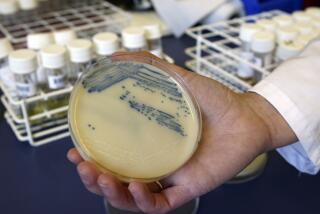U.S. Infectious Disease Deaths Rise Markedly
- Share via
Counting virtually every American who died from 1980 to 1992, federal researchers have found that deaths from infectious diseases, formerly on the decline, rose 58% over that period, jumping from the fifth to the third leading killer.
Although the AIDS epidemic accounts for most of that rise, the researchers also documented a “surprising” increase in hard-to-explain respiratory infections among the elderly and blood infections among people of all ages. Even when they excluded AIDS from the analysis, the researchers said, the infectious disease death rate had risen 22% by 1992, the most recent year for which national records were complete.
“A lot of people expected infectious disease deaths to go away as a public health problem, but this study clearly shows that they’ve gone up,” said the study’s lead author, Dr. Robert W. Pinner of the Centers for Disease Control.
The study appears in today’s Journal of the American Medical Assn., which contains more than a dozen articles on new or reemerging infectious diseases. Today’s issue kicks off what the editors call the first-ever globally coordinated medical publishing venture. This month, 36 journals in 21 countries, from China to Iceland, are calling attention to the apparently growing threats to life and well-being posed by microbes in each nation.
Among other findings presented in the AMA journal:
* Blood infections with drug-resistant strains of the strep bacteria that cause pneumonia are on the rise, according to a study in Franklin County, Ohio. From 1991 to 1994, the researchers documented a more than threefold increase in invasive strep bacteria, from 4% to 14%.
* Underuse of pneumonia vaccine is imperiling thousands of Americans, researchers say. Although the vaccine is recommended for everyone over 65, for instance, no more than 30% of people in that age group receive it, according to the National Center for Health Statistics.
* If global warming occurs, malaria, dengue fever and other tropical or subtropical insect-borne microbial diseases could spread northward, perhaps triggering U.S. epidemics, Johns Hopkins University researchers speculate. “Global climate change can alter the distribution of infectious diseases,” they say, “placing new and potentially large human populations at risk.”
* The human immunodeficiency virus, which causes AIDS, is likely to continue mutating, perhaps developing strains that elude conventional screening tests. To address that “major public health concern,” CDC researchers are calling for a new worldwide network of labs to measure subtle changes in HIV’s genetic makeup and invent new tests that screen for unusual strains.
Pinner and his co-workers found that largely because of AIDS, the biggest jump in infectious disease deaths--a more than sixfold increase from 1980 to 1992--occurred among males 25 to 44. They had five times the death rate of females the same age.
Among the elderly, deaths from underlying infection rose 25% over the study period, the researchers say. Some of that increase reflected the growing numbers of elderly people, Pinner explained, but it also appears that the elderly are more susceptible to respiratory infections, perhaps because pneumonia bugs have be come more virulent and more hardy.
One of the most worrisome trends, he said, was that fatal blood infections rose 83% in those 12 years, to 7.7 per 100,000 deaths in 1992. “I don’t think we have good explanations for the increase in the bloodstream infections death rate,” Pinner said.
But not all the new data suggest that the microbes are winning every confrontation. The researchers found no increase in deaths by infection in the 5-to-24-year-old group, and the death rate actually dropped for newborns and toddlers.
And while infectious diseases are now the nation’s third leading cause of death, behind heart disease and cancer, the toll amounted to only 8% of the more than 2 million deaths in 1992. The actual consequences of infectious diseases are greater than that figure suggests because many deaths attributed to other causes, such as liver failure, may have been abetted by infection.
In a somewhat gloomy editorial in the AMA journal, Dr. Joshua Lederberg, a Nobel laureate at Rockefeller University, said that “we have unprecedented mixing of people: A million passengers a day cross national boundaries by air, not to mention the movements of armies, refugees and road transport as well-documented vehicles for the rapid spread of disease. . . . We have never been more vulnerable.”
Still, medical researchers warning of this newly urgent danger run the risk of alarming the public. The AMA’s council on scientific affairs said in a statement that “public perception from media reports . . . is that the threat to general health caused by infectious diseases is as great today as at any time in the nation’s history. This conclusion is far from the truth.” As evidence of progress, the council cites victories over such bygone scourges as smallpox, diphtheria and poliomyelitis.
(BEGIN TEXT OF INFOBOX / INFOGRAPHIC)
Infectious Disease Deaths
The fifth-leading cause of U.S. deaths in 1980, infectious diseases jumped to third by 1992, behind heart disease and cancer, largely because of AIDS and the aging of the population. Here, the change in the 10 most deadly infectious diseases:
*--*
TYPE OF MORTALITY PER INFECTION 100,000 1980 1992 Respiratory tract 25.1 30.3 HIV/AIDS not included 13.2 Blood (septicemia) 4.2 7.7 Kidney/urinary tract 3.5 4.9 Heart 1.1 1.5 Liver/gallbladder 0.5 1.5 Fungal 0.3 0.9 Tuberculosis 1.0 0.7 Gastrointestinal tract 0.6 0.4 Babies infected during 0.5 0.4 or shortly after birth
*--*
Infectious diseases death rates per 100,000 U.S. population
Source: Journal of the American Medical Assn.






